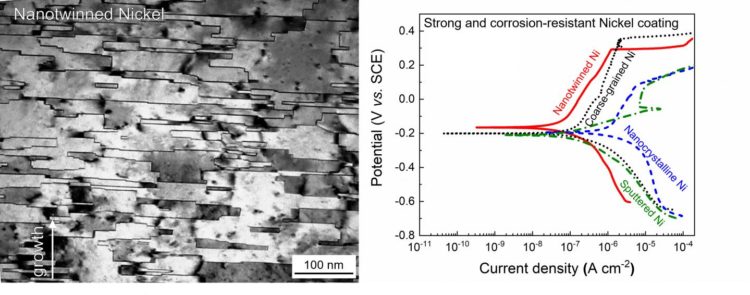
Credit: Qiang Li/Purdue University
WEST LAFAYETTE, Ind. – Nickel is a widely used metal in the manufacturing industry for both industrial and advanced material processes. Now, Purdue University innovators have created a hybrid technique to fabricate a new form of nickel that may help the future production of lifesaving medical devices, high-tech devices and vehicles with strong corrosion-resistant protection.
The Purdue technique involves a process where high-yield electrodeposition is applied on certain conductive substrates. The Purdue team’s work is published in the December edition of Nanoscale.
One of the biggest challenges for manufacturers with nickel is dealing with the places within the metals where the crystalline grains intersect, which are known as the boundary areas. These conventional grain boundaries can strengthen metals for high-strength demand.
However, they often act as stress concentrators and they are vulnerable sites for electron scattering and corrosion attack. As a result, conventional boundaries often decrease ductility, corrosion resistance and electrical conductivity.
Another specific type of boundary, much less common in metals such as nickel due to its high-stacking fault energy, is called a twin boundary. The unique nickel in a single-crystal-like form contains high-density ultrafine twin structure but few conventional grain boundaries.
This particular nickel has been shown by the Purdue researchers to promote strength, ductility and improve corrosion resistance. Those properties are important for manufacturers across several industries – including automotive, gas, oil and micro-electro-mechanical devices.
“We developed a hybrid technique to create nickel coatings with twin boundaries that are strong and corrosion-resistant,” said Xinghang Zhang, a professor of materials engineering in Purdue’s College of Engineering. “We want our work to inspire others to invent new materials with fresh minds.”
The solution of the researchers at Purdue is to use a single crystal substrate as a growth template in conjunction with a designed electrochemical recipe to promote the formation of twin boundaries and inhibit the formation of conventional grain boundaries. The high-density twin boundaries contribute a high mechanical strength exceeding 2 GPa, a low corrosion current density of 6.91 × 10?8 A cm?2, and high polarization resistance of 516 kΩ.
“Our technology enables the manufacturing of nanotwinned nickel coatings with high-density twin boundaries and few conventional grain boundaries, which leads to superb mechanical, electrical properties and high corrosive resistance, suggesting good durability for applications at extreme environments,” said Qiang Li, a research fellow in materials engineering and member of the research team. “Template and specific electrochemical recipes suggest new paths for boundary engineering and the hybrid technique can be potentially adopted for large-scale industrial productions.”
Potential applications for this Purdue technology include the semiconductor and automotive industries, which require metallic materials with advanced electric and mechanical properties for manufacturing. The nanotwinned nickel can be applied as corrosion-resistant coatings for the automobile, gas and oil industries.
The new nickel hybrid technique can be potentially integrated to the micro-electro-mechanical system industry after careful engineering designs. MEMS medical devices are used in critical care departments and other hospital areas to monitor patients.
The relevant pressure sensors and other functional small-scale components in MEMS require the use of materials with superior mechanical and structural stability and chemical reliability.
###
The team worked with the Purdue Research Foundation Office of Technology Commercialization to patent the technology. They are looking for partners. For more information on licensing and other opportunities, contact D.H.R. Sarma from OTC at [email protected].
The research has been funded by the Department of Energy’s Basic Energy Science program. The Purdue team worked with scientists from Sandia National Laboratories on the technology.
About Purdue Research Foundation Office of Technology Commercialization
The Purdue Research Foundation Office of Technology Commercialization operates one of the most comprehensive technology transfer programs among leading research universities in the U.S. Services provided by this office support the economic development initiatives of Purdue University and benefit the university’s academic activities through commercializing, licensing and protecting Purdue intellectual property. The office is managed by the Purdue Research Foundation, which received the 2019 Innovation and Economic Prosperity Universities Award for Place from the Association of Public and Land-grant Universities. The Purdue Research Foundation is a private, nonprofit foundation created to advance the mission of Purdue University. Visit the Office of Technology Commercialization for more information.
Writer: Chris Adam, 765-588-3341, [email protected]
Sources: Xinghang Zhang, [email protected]
Qiang Li, [email protected]
Media Contact
Chris Adam
[email protected]
Original Source
https:/
Related Journal Article
http://dx.





